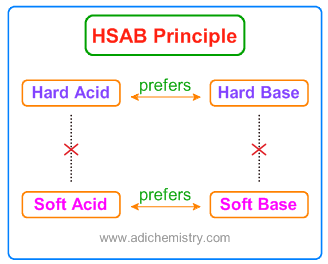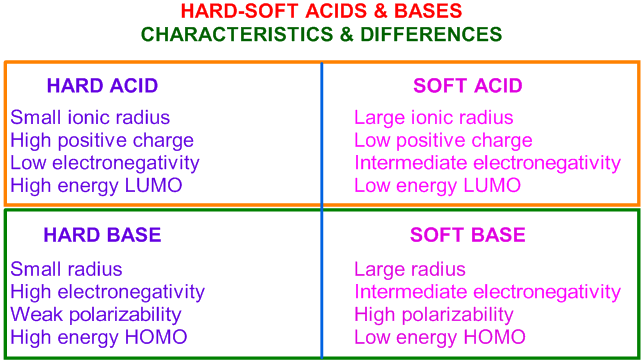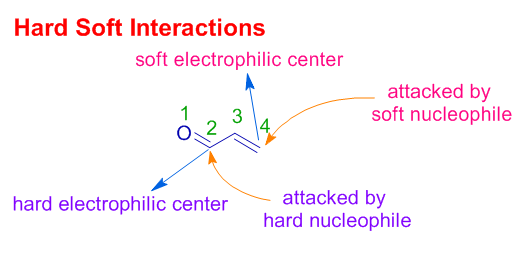
Hard and Soft Acids and Bases (HSAB) Principle is a qualitative concept introduced by Ralph Pearson to explain the stability of metal complexes and the mechanisms of their reactions. However, it is also possible to quantify this concept based on Klopman's FMO analysis using interactions between HOMO and LUMO. The principle, definitions, examples, theoretical basis, applications and limitations of Pearson's HSAB theory are presented in this document.
According to HSAB principle, the Lewis acids and bases can be further divided into hard or soft or borderline types.
Hard Lewis acids are characterized by small ionic radii, high positive charge, strongly solvated, empty orbitals in the valence shell and with high energy LUMOs.
Soft Lewis acids are characterized by large ionic radii, low positive charge, completely filled atomic orbitals and with low energy LUMOs.
Hard Lewis bases are characterized by small ionic radii, strongly solvated, highly electronegative, weakly polarizable and with high energy HOMOs.
Soft Lewis bases are characterized by large ionic radii, intermediate electronegativity, highly polarizable and with low energy HOMOs.
The Borderline Lewis acids and bases have intermediate properties.
Remember that it is not necessary for Lewis acid or base to possess all the properties to be classified as hard or soft or borderline.
In short, Hard acids and bases are small and non-polarizable, whereas Soft acids and bases are larger and more polarizable.
According to HSAB concept, hard acids prefer binding to the hard bases to give ionic complexes, whereas the soft acids prefer binding to soft bases to give covalent complexes. It is sometimes referred to as Hard-Soft Interaction Principle (HSIP).

* The large electronegativity differences between hard acids and hard bases give rise to strong ionic interactions.
* The electronegativities of soft acids and soft bases are almost same and hence have less ionic interactions. i.e., the interactions between them are more covalent.
* The interactions between hard acid - soft base or soft acid - hard base are mostly polar covalent and tend to be more reactive or less stable. The polar covalent compounds readily form either more ionic or more covalent compounds if they are allowed to react.
According to FMO analysis, the interactions between acids and bases are controlled by the relative energies of the participating frontier molecular orbitals (FMO) i.e., HOMO and LUMO.
Greater the energy gap between the HOMO & LUMO, harder is the species.
Quantitatively the absolute hardness of a species is determined by following equations.

or

| Type of Acid/Base | CHARACTERISTICS | EXAMPLES |
| Hard acids | * Atomic centers of small ionic radii (<90
pm). * High positive charge. * Empty orbitals in their valence shells. * Low electronegativity (0.7-1.6) and low electron affinity. * Likely to be strongly solvated. * High energy LUMO. |
H+, Li+, Na+, K+,
Be2+, Mg2+, Ca2+, Sr2+, Sn2+ Al3+, Ga3+, In3+, Cr3+, Co3+, Fe3+, Ir3+, La3+, Si4+, Ti4+, Zr4+, Th4+,U4+, VO2+ , UO22+ BeMe2, BF3, BCl3, B(OR)3, AlMe3 |
| Soft acids | * Large radii (>90 pm). * Low or partial positive charge. * Completely filled orbitals in their valence shells. * Intermediate electronegativities (1.9-2.5) * Low energy LUMOs with a large magnitude of LUMO coefficients. |
Cu+, Ag+, Au+, Hg+
, Cs+ , Tl+ , Hg2+ , Pd2+,
Cd2+ , Pt2+ Metal atoms in zero oxidation states BH3 |
| Borderline acids | Fe2+ , Co2+ , Ni2+ , Cu2+ , Zn2+ , Pb2+ , B(CH3)3, SO2, NO+ | |
| Hard bases | * Small radii (around 120pm) & highly
solvated. * electronegative atomic centres (3.0-4.0). * Weakly polarizable. * Difficult to be oxidized. * High energy HOMO. |
H2O, OH-, F-, Cl-, CH3CO2-, PO43-, SO42-, CO32-, NO3-, ClO4-, ROH, RO-, R2O, NH3, RNH2, N2H4 |
| Soft bases | * Large atoms (>170 pm) with intermediate electronegativity (2.5-3.0). * High polarizability * Easily undergo oxidation. * Low energy HOMOs but large magnitude HOMO coefficients. |
S2-, RSH, RS-, R2S, I-, CN-,
SCN-, S2O3-, R3P,
R3As, (RO)3P, RNC, CO, C2H4, C6H6, R-, H- |
| Borderline bases | Aniline, pyridine, N3-, Br-, NO2-, SO32-, N2 |

There are numerous applications of the HSAB principle. It helps in understanding organic reaction mechanisms, metal-ligand interactions in metal complexes, ore processing in metallurgy, precipitations in qualitative analysis etc.
The strong hydrogen bond is possible in cases of H2O, NH3, and HF, since the donor atoms (F, O & N) are hard Lewis bases and their interactions with partially positively charged H, which is a hard acid, are stronger.
It is one of the important applications of the HSAB principle. The SCN- ligand is an ambidentate ligand and can be S-bound to metal (M-SCN) and referred to as thiocyanate or can be N-bound to metal (M-NCS) and is referred to as isothiocyanate. The choice among S-bound or N-bound is decided by soft or hard acid-base behavior. S is a comparatively soft base than N atom. Hence soft metal ions are S-bound while hard metal ions are N-bound.
1) SCN- bonds through sulfur atom (soft base) when bonded to Pt2+, a soft acid.
2) It bonds through nitrogen atom (a hard base) when linked to Cr3+, a hard acid.
3) When Fe2+ reacts with SCN- a bright red [Fe(SCN)]+ ion is formed, whereas Cr3+ forms [Cr(NCS)]2+.
Reason: Fe2+ is a borderline acid and is S-bound. Whereas Cr3+ is hard acid and prefers to be N-bound.
4) The molecule (CH3)2NCH2PF2 would bond to BF3 through N whereas it would bond to BH3 through P.
Reason: BF3 is a hard acid and prefers to bind with N atom - a hard base. Whereas, BH3 is a soft acid and preferentially bonded to soft base, P atom.
Symbiotic effect: The hard-soft character of the metal ion is altered by the other groups attached. It is referred to as a symbiotic effect.
For example, the isolated Co3+ is a hard acid and is expected to make the bond with SCN- ion through N atom as observed in [Co(NH3)5(NCS)]3-.
However, when bound to five soft base ligands like CN- ions, the hardness of cobalt ion (Co3+)is reduced. Thus [Co(CN)5]2- behaves as a soft acid and prefers to bind with SCN- ion through S atom to form [Co(CN)5(SCN)]3-.
HSAB principle is used to predict the outcome of few of the reactions. We can predict whether a reaction proceeds to the right or left based on soft or hard acid/base interactions.
1) The reaction between AsF3 and PI3 is possible and proceeds to the right since As3+ is softer than P3+ and I- is softer than F-.
![]()
Remember that both As3+ and P3+ are soft but relatively As3+ is softer due to larger size.
2) The reaction between MgS and BaO as shown below is possible since Mg2+ is harder acid than Ba2+ and O2- is harder base than S2-.
![]()
3) P2F4 can be prepared by treating PF2I with mercury as shown below.
2PF2I + 2Hg ------> Hg2I2 + P2F4
In this reaction, it is iodine rather than fluorine that is removed from PF2I.
Explanation: Hg22+ ion is a soft acid that prefers soft base I- rather than hard base F-.
The compound formed due to soft acid-soft base combination is more covalent and less soluble in polar solvents like water. For example, Silver iodide, AgI is insoluble in water as it has covalent nature since it is the combination of soft acid, Ag+ and soft base, I-.
On the other hand, Lithium iodide, LiI is the result of a combination of Li+ (hard acid) and I- (soft base). Thus it is polar covalent and thus soluble in water.
We know that the hard metals prefer to bind with hard anions and thus they are available as oxides or fluorides or carbonates or silicates in nature. Whereas, the soft metals prefer to bind with soft anions and hence are found in nature as sulfides or phosphides or selenides.
E.g. Aluminium is mostly found in nature as alumina, Al2O3 - an oxide ore, since Al3+ is a hard metal which prefers to combine with hard oxide anion rather than the soft sulfide ion.
Silver & copper metals exist as sulfide ores since both Ag+ and Cu2+ are soft metals.
The f-block elements are found in nature as silicate minerals since the trivalent lanthanides are actinides are hard acids and tend to bind with hard oxygen bases as in silicates.
The softer acids like Ag+, Hg+, Hg2+ etc., and borderline acids like Fe2+, Ni2+, Cu2+, Zn2+, Pb2+ etc., can be precipitated as sulfides from their aqueous solutions since S2- ion is a softer base. Following table illustrates the separation of cations based on their hardness or softness.
| HSAB and Qualitative Analysis | |||||
| Separation Table | |||||
| Group-1 | Group-2 | Group-3 | Group-4 | Group-5 | |
| HSAB acid | Soft | Borderline & soft | Borderline | Hard | Hard |
| Reagent | HCl | H2S (acidic) | H2S (basic) | (NH4)2CO3 | Soluble |
| Precipitates | AgCl | HgS | MnS | CaCO3 | Na+ |
| PbCl2 | CdS | FeS | SrCO3 | K+ | |
| Hg2Cl2 | CuS | CoS | BaCO3 | NH4+ | |
| SnS | NiS | ||||
| As2S3 | ZnS | ||||
| Sb2S3 | Al(OH)3 | ||||
| Bi2S3 | Cr(OH)3 | ||||
1) RCOX is a hard acid and reacts with the nitrogen end of SCN- ion to form an acyl isothiocyanate.
![]()
2) Whereas the softer methyl group bonds to the Sulfur atom and forms methyl thiocyanate.
![]()
The α,β-unsaturated carbonyl compounds have two types of carbon electrophilic centers.
1) Carbonyl carbon - Hard electrophilic center.
2) β-carbon - Soft electrophilic center.

Therefore, the hard nucleophiles like Grignard reagents attack the carbonyl carbon (hard electrophile) resulting in 1,2-nucleophilic addition to C=O group.
E.g.,

Whereas, the soft nucleophiles like Lithium organocuprates, thiols etc. attack the β-carbon (soft nucleophile) resulting in 1,4-conjugate addition.

Pearson's HSAB theory is in direct contradiction with Fajan's rules. For example, the later predict the nature of Beryllium salts to be more covalent. But according to the HSAB principle, the Be2+ ion is hard acid and is expected to show charge controlled bonding that results in more ionic nature for beryllium compounds. But this is not true.
Since hydrogen ion, H+ is a hard acid and hydride ion, H- is a soft base, according to HSAB principle the interactions between them must be polar covalent and H2 must be unstable. Indeed H2 is a stable molecule with pure covalent nature.
Question-1: Which of the following is a borderline acid ?
A) Fe2+
B) Cu2+
C) Zn2+
D) All
Answer: D
Question-2: Which of the following is a soft acid ?
A) Ag+
B) Pt2+
C) Au+
D) All
Answer: D
Question-3: Which of the following is not a hard acid ?
A) H+
B) Li+
C) BH3
D) BF3
Answer: C
Question-4: Which of the following will combine with BH3 to form a stable complex?
A) CO
B) Pt2+
C) OH-
D) methane
Answer: A